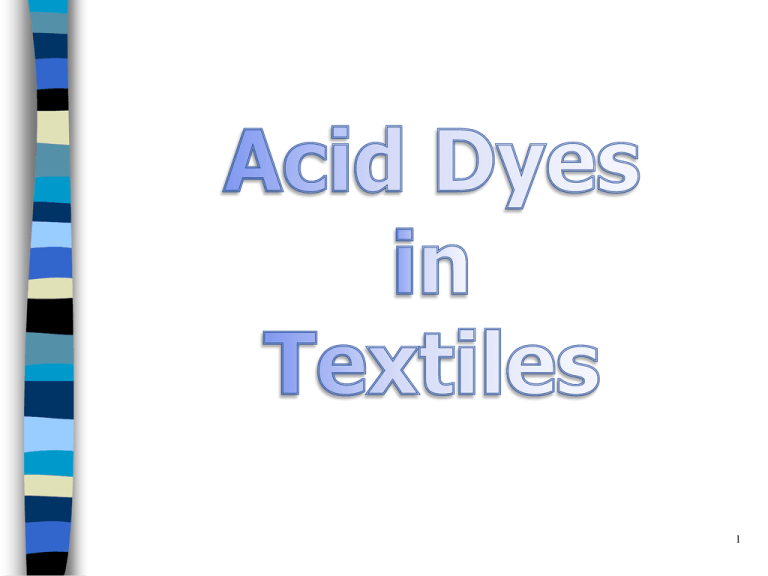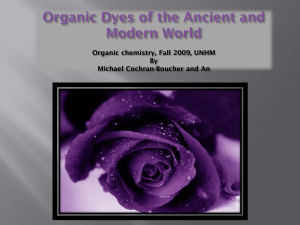Textile Dyeing
advertisement

1 Acid Dye (Anionic Azo dyes) Acid dye class is a water soluble class of dyes with anionic properties. The textile acid dyes are specially effective for protein fibers such as silk, wool, nylon and modified acrylics. These are applied from a strongly acidic to neutral pH bath. Acid dyes fix to the fibers by means of • Hydrogen bonding • Vander waals forces • Ionic Linkages 2 In Azo dyes the uptake rate of the dye is controlled with the use of sodium chloride. They are often applied from an acidic solution in order to intensify the staining. Note : The acid used in the dye bath is acetic acid or citric acid. These dyes have no affinity for cotton cellulose’s , hence not suitable for cellulosic. 3 Mechanism of dyeing with acid dyes Acid dyes in aqueous solvent, produces a colored anion, which can be described as follows. The protein and polyamide fibers produce cationic sites in water under acidic conditions and as the acidity of the solution is increased more cationic sites are produced under these strongly acidic conditions. 4 The above shown bonds have linkages which are strong enough to break and thus dyeing produced are fast and efficient in industry point of view. Reaction between an acid dye and wool can be represented by following equation 5 When describing the detail in above equation in Protein fibers contain amino and carboxyl groups, ionized mostly to NH3+ and COOIn the acid dye bath the carboxylate ions are converted to undissociated carboxyl groups owing to the addition of acid HX It causes the positively charged wool (H3N+.W.COOH) to take up an equivalent amount of acid anions X hence build the bond in between dye molecule and the fiber 6 The action of Retarding agents in Acidic Dye bath • Electrolyte (Nacl) in the acid dye bath acts as a retarding agent because of chlorides ions attracted by the positive sites at the fiber and in the competition between. • Addition of acid acts as an exhausting agent , because strongly acidic conditions makes more cationic sites available and thus available dye anions got combined with these. 7 Acid dyes are divided into three groups based on their differences in • Affinity • Based on the leveling properties • Economy of the dyeing and fastness properties 8 Leveling dyes • Highest level dyeing properties. • Quite combinable in trichromatic shades. • Relatively small molecule therefore high migration before fixation. • Low wet fastness therefore normally not suited for apparel fabric. 9 Milling dyes • Medium to high wet fastness. • Some milling dyes have poor light fastness in pale shades. • Generally not combinable. Used as self shades only. 10 Metal complex acid dyes More recent chemistry combined transition metals with dye precursors to produce metal complex acid dyes with the highest light fastness and wet fastness. These dyes are • Economical. • Very good light fastness even in pale shades 11 Acid Dye Structures 12 Dye Structures Acid dyes usually have a sulfo or carboxy group on the molecule making them soluble in water. Most acid dyes are related in basic structure to the following: Anthraquinone Many acid dyes are synthesized from chemical intermediates which form anthraquinone-like structures as their final state. Many blue dyes have this structure as their basic shape. The structure predominates in the levelling class of acid dye. 13 Synthetic dyes are often derived from 9,10anthraquinone, such as alizarin. Important derivatives are 1-nitroanthraquinone, anthraquinone-1-sulfonic acid, and the dinitroanthraquinone. From the left: C.I.Acid Blue 43 an "acid dye" for wool (also called "Acilan Saphirol SE"), C.I. Vat Violet 1, which is applied by transfer printing using sublimation, a blue colorant commonly used in gasoline, and C.I. Disperse Red 60, 14 a so-called vat dye. Azo dyes • The structure of azo dyes is based on azobenzene • Although Azo dyes are a separate class of dyesuff mainly used in the dyeing of cotton (cellulose) fibers. • Many acid dyes have a similar structure, and most are red in color. Yellow azo dye 15 Triphenylmethane • Acid dyes having structures related to triphenylmethane predominate in the milling class of dye. • There are many yellow and green dyes commercially applied to fibers that are related to triphenylmethane. Bromocresol green 16 Acid Dyeing Techniques 17 Acid dyeing techniques Textile Auxiliaries used in acid dyeing • Leveling agent - for levelness dyeing • Retarding agent - for inhibiting the dye not attach to fibers too fast • Acid - adjust the dyeing condition and make the fibers to show positive charges • Water - dyeing media 18 Dyeing temperature The dyeing is generally carried out at boiling temperature for 30- 60 minutes depending upon the depth of the shade and dyestuffs used. Dyeing leveling agents In the case dyeing with acid dyes , mainly cationic agents such as ethoxylated fatty amines are used as leveling agents. Heating rates Heating rate is generally kept 1-30C/Min 19 Wool dyeing method with acid dyes 20 Detail about the graph • At A set bath at 50° with: 2% Formic Acid (85%) 5% Glaubers Salt anhydrous • pH 3.5 to 4.5 • At B add required amount of dye. • At C add 2% Sulphuric Acid (96%) or 2% Formic Acid (85%). • Thoroughly rinse after dyeing to remove loose colour. 21 A dyeing cycle for Nylon filament dyeing A textured yarn one dye bath. It nylons 6,6. One rejects cationic opposite way can achieve multicolor effects in is a combination of two modified nylon only accepts acid dye and dye; the other one acts the 22 Fastness properties of acid dyes The wet and light fastness properties of the acid dyes varies from poor to excellent , depending upon the molecular structure of the dyes. The fastness properties as per the category are as follows Level acid dyes: since these dyes have very good leveling and migration properties ,and have a low affinity for the fiber, therefore the wet fastness properties of this class are 23 generally poor. milling dyes :- These dyes have a medium to good affinity for the fiber and are generally applied in a weakly acidic bath, shows medium to good wet fastness properties. Metal complex acid dyes :-These dyes have poor exhaustion properties, therefore applied under very strong acidic condition , exhibit good fastness properties. 24 Group Members with their Contributions From 061001P – 061015L including 051055A 25 26




